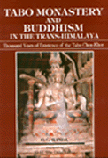Tabo Monastery and Buddhism in the Trans-Himalaya Thousand Years of Existence of the Tabo Chos-Khor
| |||||||||||||||||
|
Editeur - Casa editrice |
Indus Publishing Company |
|
|||||||||||||||
|
Città - Town - Ville |
Delhi | ||||||||||||||||
|
Anno - Date de Parution |
1994 | ||||||||||||||||
|
Pagine - Pages | 167 | ||||||||||||||||
|
Titolo originale | Tabo Monastery and Buddhism in the Trans-Himalaya: Thousand Years of Existence of the Tabo Chos-Khor | ||||||||||||||||
|
Lingua originale | |||||||||||||||||
|
Lingua - language - langue | eng | ||||||||||||||||
|
|
|||||||||||||||||
|
|
|
"Questo libro è uno studio completo dell'ascesa e dello sviluppo del Buddhismo in un contesto spazio-temporale più ampio della regione trans-himalayana occidentale fin dai suoi giorni nascenti in India. La successiva fioritura del Buddhismo nel mondo tibetano e l'emergere del regno buddhista di Guge nel Tibet occidentale sono stati discussi nel contesto della politica trans-himalayana contemporanea.
Recensione in altra lingua (English): |
| "This book is a comprehensive study of the rise and development of Buddhism in a broader spatio-temporal context of the western trans-Himalayan region since its nascent days in India. The later efflorescence of Buddhism in the Tibetan world and the emergence of Buddhist kingdom of Guge in the western Tibet has been discussed in the context of the contemporary trans-Himalayan polity. | |||||||||||||
| Recensione in lingua italiana | |||||||||||||||||
|
Il monastero di Tabo è per me un "luogo" di nostalgia ormai da anni. Ho visitato questo antico centro di pellegrinaggio buddhista per la prima volta nel luglio del 1992. L'amico Arhoi ci aveva informato che lo Spiti era stato aperto ai turisti. Fummo non solo il primo gruppo di Avventure, ma proprio fra i primi stranieri ad essere ammessi nella valle. Ricordo la corsa in jeep per ottenere a Keylong i permessi per valicare la "inner line", il passaggio del KamZam, la notte passata bivaccando a bordo del bus perché non c'era spazio per le tende ed infine lo stupore di arrivare a Tabo. | |||||||||||||||||
| Biografia | |||||||||||||||||
|
Dr. O.C. Handa is a well-known connoisseur of art and culture, and an outstanding scholar in history and archaeology, especially of the Himalayan region, having been in the field for almost half a century. In his pursuits, he has been undertaking several exploratory visits to the farflung nooks and corners of the Western and Central Himalayan regions. That would underscore his zeal to explore the antique but extant material evidences of history, art and culture of the Himalayan region, and his commitment to acquire first-hand and authentic knowledge of various interesting and important aspects of this region. This quality is well reflected in his writings. He did his post-graduation in History from University of Mysore, Ph.D. from Meerut University and D.Lit. form Agra Univ. Having come from civil engineering background, he remained in-charge of the Department of Museum & Archaeology, Himachal Pradesh for several years. | |||||||||||||||||
| |||||||||||||||||




 Tabo Monastery and Buddhism in the Trans-Himalaya
Tabo Monastery and Buddhism in the Trans-Himalaya